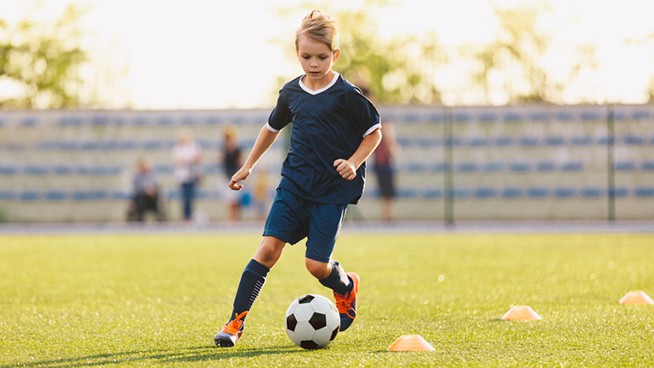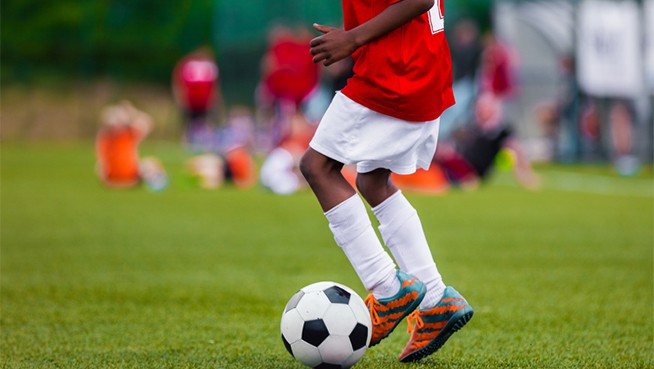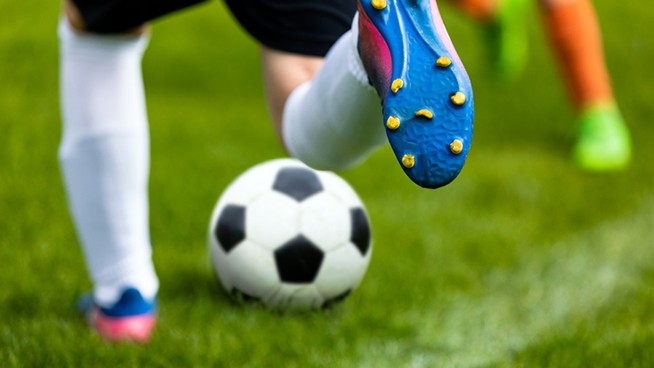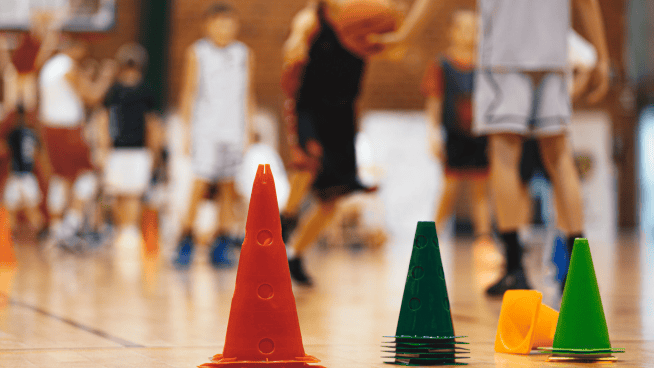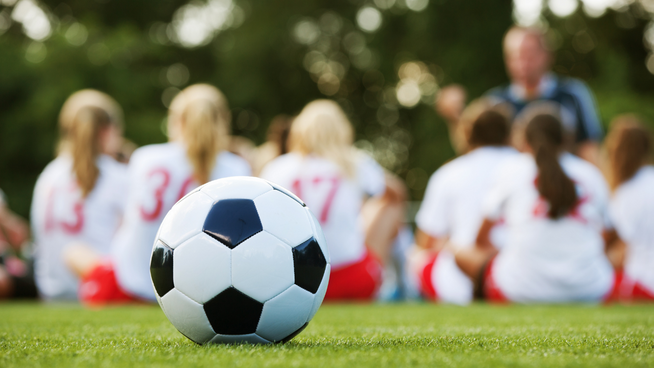Soccer Dribbling Drills to Help You Beat More Defenders on the Pitch
Scoring goals is at the heart of “the beautiful game,” but beating defenders in soccer is what makes the crowd rise up out of their seats.
They’re also the moments that create goal-scoring opportunities and give the game its excitement and texture. Whether it be a Scissors move, a Fake, a Nutmeg or a crafty acceleration that leaves a defender in the dust, beating players in one-on-one situations is a skill that must be practiced with repetition and then executed with confidence. A recent study found that skill—more so than size, strength, speed, balance and fitness—was the single biggest predictor of in-game success for soccer players. If you’re not skilled enough to beat defenders in one-on-one situations, your performance will suffer.
Here are four soccer dribbling drills to help you beat more defenders on the pitch.
1. Get Confident With Creative Soccer Dribbling Drills
Would a soccer player rather be compared to a predictable robot or a spontaneous magician? Let’s hope you said the latter.
To that end, creativity is the secret weapon that ensures a defender cannot predict an attacker’s next move. Since the game is 90-minutes long, defenders are bound to figure out a player who lacks creativity. Can he or she beat a defender left and right? Can he or she do more than the same move every time? Knowing how to perform multiple moves at any given time is bound to confuse defenders and make them fear your next one-on-one battle.
The best way to practice creativity is to be comfortable on the ball by performing “freestyle” soccer dribbling drills.
The drill shown in the video above is an example of one that has no rules and little structure, but helps a player become more comfortable with the ball at their feet. The dribbler must simply stay in constant motion (30-second intervals work well) in and around the circle of cones and do whatever it takes to avoid the cones. You’ll naturally find yourself practicing a wide variety of dribbling moves as you navigate through the crowd of cones.
This drill is perfect for learning how to swirl around in tight spaces, be competent with multiple directions, and explore new skills. Creativity is all about experimentation and figuring out what works best for your feet.
Performing uncertain reaction drills with a partner can help simulate the spontaneous decision-making process. In this drill, a partner simply drops cones in front of the dribbler at random intervals and the dribbler must make a move to avoid them:
Once you’ve mastered these drills, it’s important to have the confidence to attempt to execute these moves during practice. Pulling it off will only add to your confidence and execution skills. If your execution is less than ideal, there’s very little drawback (you’re just in practice, after all) and you’ll be able to hone in on exactly what went wrong.
2. Get Comfortable With Changing Pace
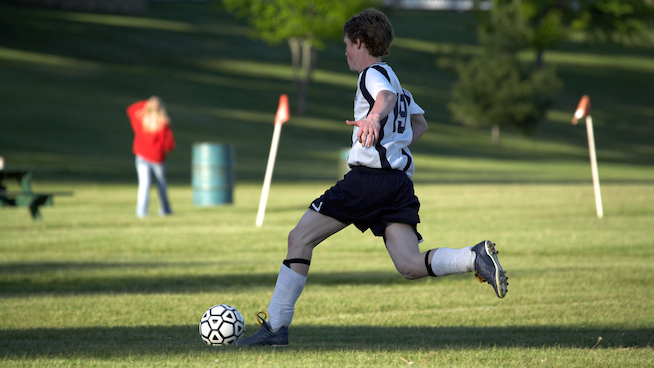
The best attackers are so comfortable with the ball at their feet that they’re able to quickly change speeds to deceive their defenders.
Since a defender’s back is to the goal during a one-on-one scenario, the one thing that will terrify him is an attacker coming at him at high speed. Defenders are already at a disadvantage because they have to turn their bodies to catch the attacker, so being able to accelerate by them after a move is the best way to dart into the box and go for the goal.
Practicing one-on-one moves at high speed also translates to the energy system demands of the game (anaerobic power), and allows players to be less susceptible to physiological and mental fatigue while performing skills. If a player is conditioned with anaerobic power, the more likely it is that their mind will be sharp when it comes to cleanly executing moves.
An attacker can also draw in a defender by decelerating as they take them on one on one, then once they create space with their move, exploding as quickly as they can to catch the defender off balance and leave them behind.
Just like creativity, speed with the ball is a multi-faceted approach. Learn how to go fast, learn how to slow down and deceive, and know when to change the pace at any given moment. The best players are rarely the ones who run all-out, all the time.
3. Train Your Lateral Power
The majority of one-on-one soccer dribbling moves are performed in the frontal plane, such as fakes, scissors and step-overs. A player can be technically gifted, but if they do not have the lateral power to explode off their plant foot, the defender is going to have more time to disrupt their dribble and they’re going to have difficulty creating separation.
This is when that behind-the-scenes training in the gym comes into play. Building real lateral power requires a myriad of strength and plyometric drills performed without the ball. One drill that is excellent for building lateral power is bounding, which can then be progressed to loaded bounding for the optimal amount of fas- twitch muscle recruitment.
4. Master the Basics
Beating defenders is all about going at them with confidence. If a player has any inkling of self doubt, it could cause hesitation. Doubt and indifference are the enemy of an effective dribbler. One way to fight that doubt is by continuing to work on creativity, lateral power and speed with the ball.
Confidence can also be developed by mastering the foundational moves a player is likely already familiar with. Once these moves can be performed with full confidence, a player can begin to integrate subtle variations.
Proficiency with basic moves as well as an ability to add new flavor to them instantly makes a player confident and unpredictable. Better yet, it allows a player to become a magician of the game rather than a robot.
Photo Credit: dennysb/iStock
READ MORE:
RECOMMENDED FOR YOU
Soccer Dribbling Drills to Help You Beat More Defenders on the Pitch
Scoring goals is at the heart of “the beautiful game,” but beating defenders in soccer is what makes the crowd rise up out of their seats.
They’re also the moments that create goal-scoring opportunities and give the game its excitement and texture. Whether it be a Scissors move, a Fake, a Nutmeg or a crafty acceleration that leaves a defender in the dust, beating players in one-on-one situations is a skill that must be practiced with repetition and then executed with confidence. A recent study found that skill—more so than size, strength, speed, balance and fitness—was the single biggest predictor of in-game success for soccer players. If you’re not skilled enough to beat defenders in one-on-one situations, your performance will suffer.
Here are four soccer dribbling drills to help you beat more defenders on the pitch.
1. Get Confident With Creative Soccer Dribbling Drills
Would a soccer player rather be compared to a predictable robot or a spontaneous magician? Let’s hope you said the latter.
To that end, creativity is the secret weapon that ensures a defender cannot predict an attacker’s next move. Since the game is 90-minutes long, defenders are bound to figure out a player who lacks creativity. Can he or she beat a defender left and right? Can he or she do more than the same move every time? Knowing how to perform multiple moves at any given time is bound to confuse defenders and make them fear your next one-on-one battle.
The best way to practice creativity is to be comfortable on the ball by performing “freestyle” soccer dribbling drills.
The drill shown in the video above is an example of one that has no rules and little structure, but helps a player become more comfortable with the ball at their feet. The dribbler must simply stay in constant motion (30-second intervals work well) in and around the circle of cones and do whatever it takes to avoid the cones. You’ll naturally find yourself practicing a wide variety of dribbling moves as you navigate through the crowd of cones.
This drill is perfect for learning how to swirl around in tight spaces, be competent with multiple directions, and explore new skills. Creativity is all about experimentation and figuring out what works best for your feet.
Performing uncertain reaction drills with a partner can help simulate the spontaneous decision-making process. In this drill, a partner simply drops cones in front of the dribbler at random intervals and the dribbler must make a move to avoid them:
Once you’ve mastered these drills, it’s important to have the confidence to attempt to execute these moves during practice. Pulling it off will only add to your confidence and execution skills. If your execution is less than ideal, there’s very little drawback (you’re just in practice, after all) and you’ll be able to hone in on exactly what went wrong.
2. Get Comfortable With Changing Pace

The best attackers are so comfortable with the ball at their feet that they’re able to quickly change speeds to deceive their defenders.
Since a defender’s back is to the goal during a one-on-one scenario, the one thing that will terrify him is an attacker coming at him at high speed. Defenders are already at a disadvantage because they have to turn their bodies to catch the attacker, so being able to accelerate by them after a move is the best way to dart into the box and go for the goal.
Practicing one-on-one moves at high speed also translates to the energy system demands of the game (anaerobic power), and allows players to be less susceptible to physiological and mental fatigue while performing skills. If a player is conditioned with anaerobic power, the more likely it is that their mind will be sharp when it comes to cleanly executing moves.
An attacker can also draw in a defender by decelerating as they take them on one on one, then once they create space with their move, exploding as quickly as they can to catch the defender off balance and leave them behind.
Just like creativity, speed with the ball is a multi-faceted approach. Learn how to go fast, learn how to slow down and deceive, and know when to change the pace at any given moment. The best players are rarely the ones who run all-out, all the time.
3. Train Your Lateral Power
The majority of one-on-one soccer dribbling moves are performed in the frontal plane, such as fakes, scissors and step-overs. A player can be technically gifted, but if they do not have the lateral power to explode off their plant foot, the defender is going to have more time to disrupt their dribble and they’re going to have difficulty creating separation.
This is when that behind-the-scenes training in the gym comes into play. Building real lateral power requires a myriad of strength and plyometric drills performed without the ball. One drill that is excellent for building lateral power is bounding, which can then be progressed to loaded bounding for the optimal amount of fas- twitch muscle recruitment.
4. Master the Basics
Beating defenders is all about going at them with confidence. If a player has any inkling of self doubt, it could cause hesitation. Doubt and indifference are the enemy of an effective dribbler. One way to fight that doubt is by continuing to work on creativity, lateral power and speed with the ball.
Confidence can also be developed by mastering the foundational moves a player is likely already familiar with. Once these moves can be performed with full confidence, a player can begin to integrate subtle variations.
Proficiency with basic moves as well as an ability to add new flavor to them instantly makes a player confident and unpredictable. Better yet, it allows a player to become a magician of the game rather than a robot.
Photo Credit: dennysb/iStock
READ MORE:

